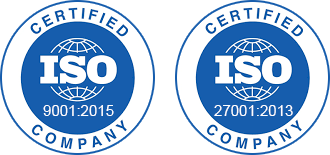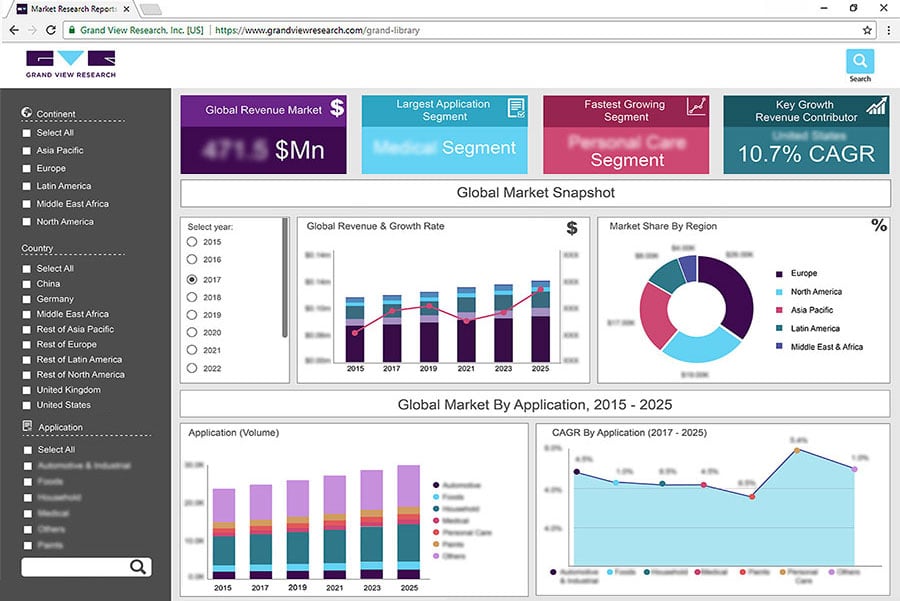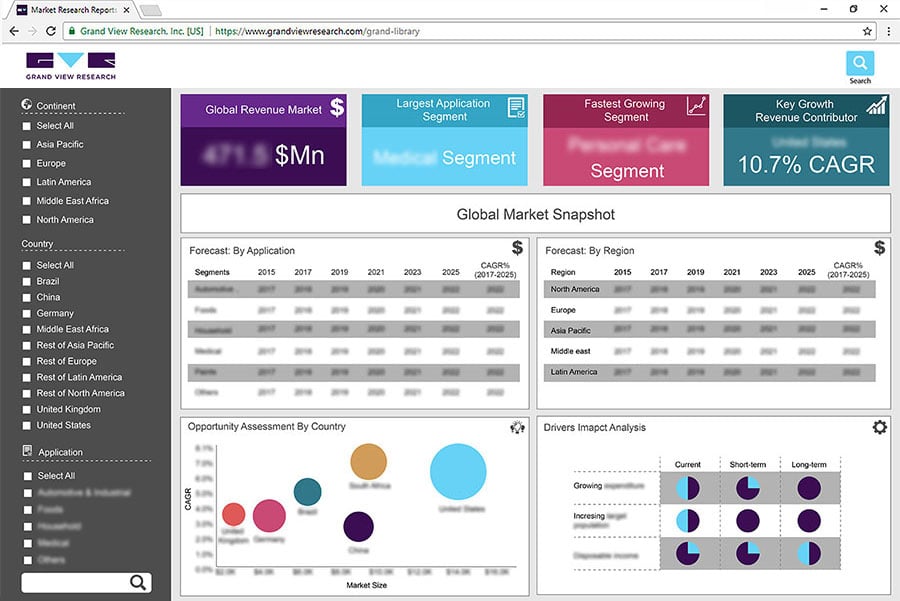- Home
- »
- Clothing, Footwear & Accessories
- »
-
Motorcycle Helmet Market Size, Share & Trends Report 2030GVR Report cover
![Motorcycle Helmet Market Size, Share & Trends Report]()
Motorcycle Helmet Market Size, Share & Trends Analysis Report By Product (Full Face, Open Face, Off-road/Racing, Others), By End-user (Rider, Passenger), By Distribution Channel (Offline, Online), By Region, And Segment Forecasts, 2023 - 2030
- Report ID: GVR-3-68038-404-8
- Number of Report Pages: 100
- Format: PDF, Horizon Databook
- Historical Range: 2017 - 2021
- Forecast Period: 2023 - 2030
- Industry: Consumer Goods
Report Overview
The global motorcycle helmet market size was valued at USD 2,287.1 million in 2022 and is expected to grow at a compound annual growth rate (CAGR) of 6.8% from 2023 to 2030. Rising awareness regarding road safety is expected to drive product demand. Moreover, an increasing number of motorbike and sports bike enthusiasts coupled with rising concerns regarding road traffic injuries across the globe is expected to drive the adoption of two-wheeler helmets during the forecast period. Road traffic accidents have become a great challenge for public authorities in terms of efforts and finding sustainable solutions for effective prevention. As per the report published by the United Nations Motorcycle Helmet Study, between 2008 and 2020, more than 3.3 million people died due to motorcycle accidents, of which about 1.4 million of these lives could be saved by making proper use of helmets.
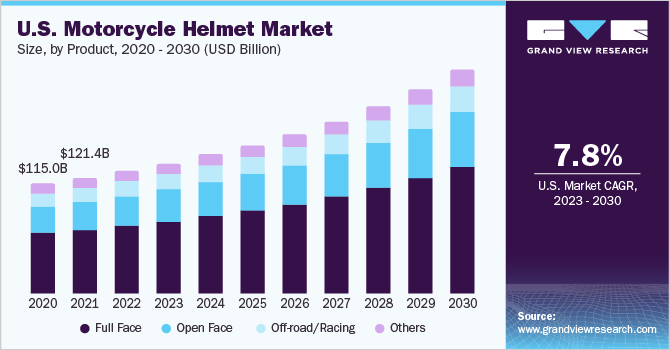
In addition, a research study by the Centers for Disease Control and Prevention (CDC) indicated that wearing a helmet can improve the chances of survival by more than 37% and can help avoid head injuries by 69.0%. Rising awareness and efforts to promote riders’ safety are the factors anticipated to drive market growth.
The worldwide outbreak of COVID-19 has brought enormous uncertainty to the global industry. To control the spread of the COVID-19 epidemic, governments around the world had adopted lockdown interventions and strict social distancing guidelines. As the coronavirus spread extensively, people around the world had begun to practice social distancing, which led to restrictions on the movement and shutdowns of production lines. All these factors affected global automotive sales.
This is the case for the motorcycle market, where global sales fell in 2020. During this period, sales in the Asia-Pacific were around 45.2 million units, which is lower than in the pre-pandemic period. This reflects the closure of some famous helmet brands such as Vicis, Schutt, etc. However, despite the uncertainty regarding the impact of the pandemic, company leaders predict that electric motor scooter services may become more popular than public transportation in the post-COVID-19 period due to improved comfort levels. Hence, this factor is likely to drive the growth of the motorcycle helmet market.
As per the data released by National Highway Traffic Safety Administration (NHTSA), in 2019, around 5,014 motorcyclists died in accidents, which is a slight decrease from 5,038 deaths in 2018. For every mile driven in 2019, motorcyclists were almost 29 times more likely to die than passenger car occupants. Whereas, around 5,579 motorcyclists died in 2020. Hence, governments around the world are taking the required steps for avoiding the increasing number of deaths caused by road accidents. For instance, the Indian government has enacted legislation on the use of helmets in second and third-tier cities to ensure traffic safety.
Technological advancements have helped market operators to introduce smart helmets into the global market. Smart helmets have advanced features to help riders to ride easily and efficiently by avoiding road accidents. Some of the smart helmet's features include GPS connectivity, voice assistance, tracking systems, cameras, Bluetooth, and Wi-Fi connectivity. Smartphones can be connected to smart helmets. This helps riders make, receive, and reject calls. Smart helmets can also help to reduce head injuries in traffic accidents. Hence, the launch of a multifunctional smart motorcycle helmet is expected to provide lucrative growth opportunities for the market.
Increasing global demand for luxury motorcycles and the growing popularity of motorcycle events and championships are the key factors expected to create good growth opportunities for helmet manufacturers. In addition, the worldwide popularity of motorsports and racing championships at national and international levels is rapidly increasing. Leading automakers such as Honda, Ducati, Suzuki, Yamaha, and Repsol Honda play an important role in the success through dealer promotions, advertising, and providing financial and technical support to teams, riders, and track operators.
Despite the life-saving benefits, some motorcyclist does not prefer riding with a helmet. According to research published by the National Center for Biotechnology Information, the most common reasons for not using a helmet are neck pain, limited head movement, suffocation, and physical discomfort due to the heavy weight of the helmet. Additionally, advanced and premium motorcycle helmets have a limited customer base due to the high cost of the product and partnerships with premium bike users. Hence, all such factors are likely to hinder the growth of the helmet market during the forecast period.
Motorcycle Helmet Market Trends
Motorcycle helmets are considered essential safety gear by many motorcycle riders. Furthermore, many manufacturers of motorcycle helmets have been coming up with high-end features to encourage consumers to wear a helmet. Few manufacturers are close to coming up with helmets featuring built-in Augmented Reality (AR) to display GPS maps and the speedometer on the helmet’s visor.
Growing inclination toward technologically advanced products has encouraged many startups to venture into the motorcycle helmet domain to offer innovative products. Recently, in July 2019, For cite launched its MK1 smart motorcycle helmet with a unique LED visual communication strip that provides additional features such as an HD wide-angle camera, Bluetooth port unit, Voice over Internet Protocol intercom (VOIP), and a handlebar-mounted control unit.
Motorcycles are among the most popular two-wheelers owing to the growing middle-class population and young population, globally. Purchasing a motorcycle eliminates the need for an individual to rely on public transport and helps them reach their destination faster. These vehicles are mainly popular among men and help them to maneuver through traffic faster, thereby driving demand for motorcycles. This increases the application of motorcycle helmets which is directly proportional to two-wheeler sales.
The rising prevalence of counterfeit helmets continues to impede market growth. Counterfeit/fake helmets are those helmets that are falsely sold and marketed at a relatively cheaper price. According to the World Health Organization report, close to 360,000 fatalities and 1.5 million injuries can be linked to defective low-quality vehicle parts and gears, every year.
These helmets may not be capable of providing appropriate comfort and protection to the wearers, as these products are usually manufactured using low-quality materials. The presence of counterfeit products also affects the consumer’s perception of the brand. The circulation of counterfeit helmets is more widespread in Asian markets, particularly in China, Pakistan, and India.
Furthermore, increasing demand for various types of helmets, such as theme-based, athletic, designer, and sports helmets has led to the flow of hundreds of thousands of counterfeit helmets flooding Asian markets. According to the U.S. Government Accountability Office, 88.0% of counterfeit products in the U.S. originate from China or Hong Kong. The easy availability of counterfeit products is likely to limit the growth of the market for helmets during the forecast period.
Product Insights
Full-face helmets accounted for a share of 59.1% of the global market in 2022. It is expected to maintain its dominance throughout the forecast period. Manufacturers are adopting advanced materials including carbon fiber and fiberglass-reinforced plastic to reduce the weight of full-face products as well as to make them safer. In addition, vendors are integrating advanced communication tools such as Bluetooth in helmets, which in turn is likely to open new business avenues during the forecast period.
The open-face segment is expected to register a lucrative growth rate during the forecast period in the market. From 2023 to 2030, the segment is anticipated to register a CAGR of 7.1%. An open helmet is a full-face helmet without a chin bar. Due to the lack of a chin, the overall weight of this helmet is less than that of a full-face helmet. During the forecast period, demand for open/half-face helmets is expected to grow as open-face helmets seem to be more popular with young people and adults. In addition, retailers are taking advantage of the e-commerce channel to sell more motorcycle helmets online with huge product discounts and promotions.
End-user Insights
Based on end-user, the market is segmented into rider and passenger. The rider segment accounted for a share of 88.1% of the global market in 2022. According to the survey held by National Occupant Protection Use, the use of Department of Transportation-compliant helmets was around 64.0 % in 2021. Although motorcycle helmet use has increased by more than 12.0% since 2002, and decreased to 8.6% since 2018. Recent estimates by the same source show that the use of helmets has decreased to 64.9% in 2021 from 69.0% in 2020.
The passenger (Pillion Rider) segment is expected to register a lucrative growth rate during the forecast period. From 2023 to 2030, pillion rider is anticipated to register a CAGR of 7.5%. To ensure maximum safety for the riders of two-wheelers, the Traffic Police has made it mandatory for the passenger riders to wear helmets along with the riders. For instance, Helmet mandatory for pillion riders in major cities in India, thereby driving the segment growth during the forecast period.
Distribution Channel Insights
Online channels are expected to expand at the fastest CAGR of 7.5% from 2023 to 2030 owing to ease of shopping and convenient product delivery. Moreover, online retailers such as Amazon and HELMEXPRESS.COM among others are focusing on this product category to capitalize on the rising product demand. In addition, e-commerce platforms, social media, and Google Ads play an essential role in influencing consumer preference.
The availability of high-speed internet and smartphones in developing countries such as India, China, Indonesia, and Vietnam is expected to promote utilization of the online platforms for purchasing motorcycle helmets. The companies are launching their exclusive websites where consumers can buy genuine products directly from the source.
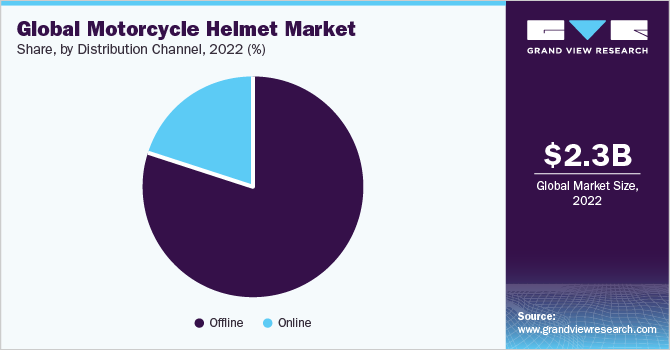
The offline distribution channel held the largest market share of 80.1% in 2022. Street vendors, convenience stores, and supermarkets are the major distribution channels in developing countries such as Thailand, Indonesia, Bangladesh, China, India, and others. Some of the local manufacturers sell the products through offline channels at prices lower than the premium brands.
Regional Insights
Asia Pacific accounted for a share of 65.1% of the global market in 2022 owing to the strong buyer foothold of the two-wheeler market in countries such as India, China, Indonesia, and Vietnam. Major manufacturers including, DaineseSpA, HJC Europe S.A.R.L, Shoei Co. Ltd, Arai Helmet Ltd, and Schuberth GmbH are launching new products to gain maximum customer penetration in the region.

The Chinese motorcycle helmet market has evolved and accounted for a significant market share of 28.7% of the Asia Pacific market in 2022. Efforts to reduce the usage of petrol-based two-wheelers and control pollution in some of the major cities have resulted in a decline in motorcycles in the country. However, demand for helmets has been on the rise due to the growth of electric two-wheelers.
India is the fastest-growing market for motorcycle helmets in the Asia Pacific owing to a large number of two-wheeler buyers in the country. The growth of the helmet industry is not only led by commuter motorcycles but even by the larger and more expensive two-wheelers. Further, the development of infrastructure in rural areas is also driving the sale of two-wheelers, and in turn, is anticipated to boost demand for helmets.
Europe is expected to register the highest growth rate during the forecast period. In the global market, Europe is anticipated to witness the highest CAGR of 8.0% from 2023 to 2030. Motorcycle registrations in this region grew by more than 7.0% in 2021, totaling 949,470 unit registrations.
However, it does not account for a significant portion of the worldwide market as people in Europe and America use motorcycles for recreational or leisure purposes, while Asians and Africans use them for daily transportation. Hence, with an increasing number of electric mopeds or motorcycles, this region is expected to exhibit the highest growth rate during the forecast period.
Key Companies & Market Share Insights
The motorcycle helmet market is characterized by the presence of several well-established players. These players account for a significant market share and have diverse product portfolios and a strong geographic presence. The recent developments and strategic initiatives carried out by players in the market mainly include product launches, collaborations, and acquisitions. Some of the key initiatives adopted by key players include:
-
In March 2023, Caberg S.p.a. launched a new flip-up/modular motorcycle helmet in the form of Levo X. The newly launched motorcycle is available in three variants including carbon, manta, and standard.
-
In September 2022, Tiivra, a startup based in Mumbai, launched composite fiber helmets in India. These helmets come in at a price of Rs 15,00. The helmets weigh merely 1,250 grams, positioning them among the lightest helmets globally.
-
In July 2022, Spark Minda launched 17 models of 2-wheeler helmets in India. These helmets are launched in 145 variants.
Some of the key players operating in the market include:
-
Dainese SpA
-
HJC Europe S.A.R.L
-
Shoei Co. Ltd
-
Arai Helmet Ltd.
-
Alpine Stars S.p.A
-
Schuberth GmbH
-
BELL HELMET
-
FOX
-
STUDDS Accessories Limited
-
Royal Enfield
-
Caberg S.p.a.
Motorcycle Helmet Market Report Scope
Report Attribute
Details
Market size value in 2023
USD 2,406.3 million
Revenue forecast in 2030
USD 3.88 billion
Growth rate
CAGR of 6.8% from 2023 to 2030
Base year for estimation
2022
Historical data
2017 - 2021
Forecast period
2023 - 2030
Report updated
August 2023
Quantitative units
Revenue in USD million and CAGR from 2023 to 2030
Report coverage
Revenue forecast, company ranking, competitive landscape, growth factors, and trends
Segments covered
Product, end-user, distribution channel, region
Regional scope
North America; Europe; Asia Pacific; Central & South America; Middle East & Africa
Country scope
U.S.; Canada; Mexico; U.K.; Germany; France; Italy; Spain; China; India; Japan; Indonesia; Vietnam; South Africa; Brazil
Key companies profiled
Dainese SpA; HJC Europe S.A.R.L; Shoei Co. Ltd; Arai Helmet Ltd.; Alpine Stars S.p.A; Schuberth GmbH; BELL HELMET; FOX; STUDDS Accessories Limited; Royal Enfield; Caberg S.p.a.
Customization scope
Free report customization (equivalent up to 8 analysts working days) with purchase. Addition or alteration to country, regional & segment scope.
Pricing and purchase options
Avail customized purchase options to meet your exact research needs. Explore purchase options Global Motorcycle Helmet Market Report Segmentation
This report forecasts revenue growth at global, regional & country levels and provides an analysis of the latest trends and opportunities in each of the sub-segment from 2017 to 2030. For the purpose of this study, Grand View Research has segmented the motorcycle helmet market on the basis of product, end-user, distribution channel, and region.
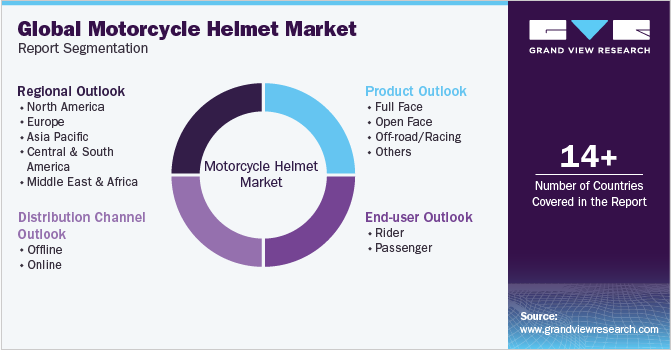
-
Product Outlook (Revenue, USD Million, 2017 - 2030)
-
Full Face
-
Open Face
-
Off-road/Racing
-
Others
-
-
End-user Outlook (Revenue, USD Million, 2017 - 2030)
-
Rider
-
Passenger
-
-
Distribution Channel Outlook (Revenue, USD Million; 2017 - 2030)
-
Offline
-
Online
-
-
Regional Outlook (Revenue, USD Million, 2017 - 2030)
-
North America
-
U.S.
-
Canada
-
Mexico
-
-
Europe
-
U.K.
-
Germany
-
France
-
Italy
-
Spain
-
-
Asia Pacific
-
China
-
India
-
Japan
-
Indonesia
-
Vietnam
-
-
Central & South America
-
Brazil
-
-
Middle East & Africa
-
South Africa
-
-
Frequently Asked Questions About This Report
b. Asia Pacific dominated the motorcycle market with a share of 65.3% in 2022. This is attributable to the strong buyer foothold within the two-wheeler space, notably in countries such as India, China, Indonesia, and Vietnam.
b. Some key players operating in the motorcycle market include Dainese SpA, HJC Europe S.A.R.L, Shoei Co. Ltd, Arai Helmet Ltd, Schuberth GmbH, and BELL HELMET. The market is highly fragmented in nature owing to the presence of a sizable number of domestic players.
b. Key factors that are driving the market growth include increasing number of motorbike and sports bike enthusiasts worldwide and rising concerns regarding road traffic injuries worldwide.
b. The global motorcycle helmet market size was estimated at USD 2,287.1 million in 2022 and is expected to reach USD 2,406.3 million in 2023.
b. The global motorcycle helmet market is expected to grow at a compound annual growth rate of 6.8% from 2023 to 2030 to reach USD 3.88 billion by 2030.
Share this report with your colleague or friend.
![gvr icn]()
NEED A CUSTOM REPORT?
We can customize every report - free of charge - including purchasing stand-alone sections or country-level reports, as well as offer affordable discounts for start-ups & universities. Contact us now
![Certified Icon]()
We are GDPR and CCPA compliant! Your transaction & personal information is safe and secure. For more details, please read our privacy policy.
We are committed towards customer satisfaction, and quality service.
"The quality of research they have done for us has been excellent."
